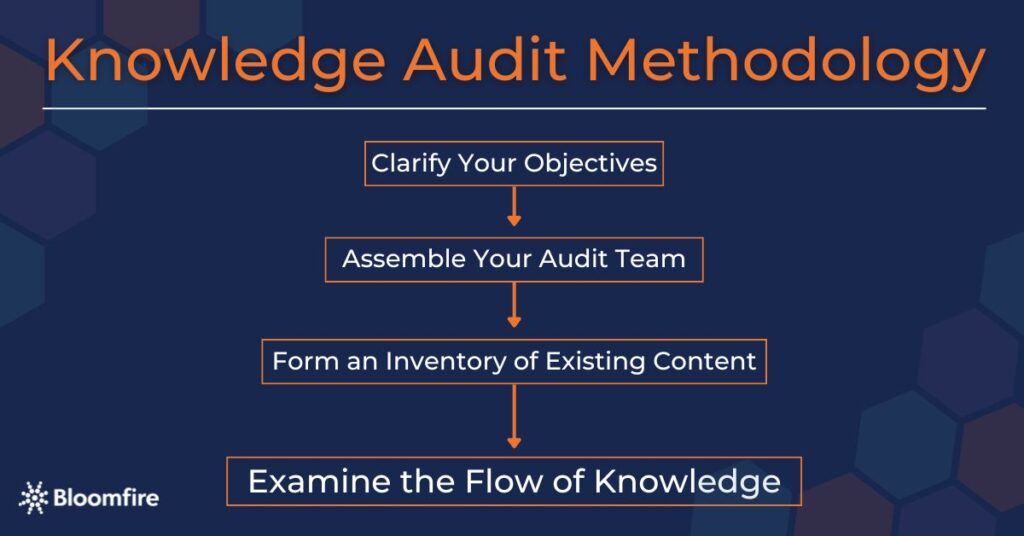What Is a Knowledge Audit and Why Does It Matter?

Your organization builds valuable knowledge and experience you can capture daily through a knowledge management (KM) platform. As they continue to grow, you’ll need to execute a knowledge audit to assess how information is utilized in your organization. This exercise allows you to compile a thorough list of the knowledge assets your company stores and lets you better evaluate the “health” of your organization’s knowledge bank.
Continue reading to learn how knowledge audit is defined, its benefits, and the steps involved in its implementation.
What Is a Knowledge Audit?
A knowledge audit involves identifying, mapping, and investigating information you have documented and stored in your organization. It aims to assess the value of your knowledge assets and is a critical step in cementing effective knowledge management in your company.
There is often confusion over the difference between content and knowledge audits. While a content audit focuses on the content your company has created, giving an overview of what exists and what doesn’t, it doesn’t provide a comprehensive context into how the organization uses it. Meanwhile, a knowledge audit looks into the strengths and weaknesses of the information and its purpose. It answers the following questions:
- What are your organization’s knowledge needs?
- What resources does your company have, and how are they managed/stored?
- What are the gaps in your company’s documented data and information?
- How is company information transferred throughout your organization?
- What is preventing your workforce from sharing knowledge across your company?
Once you start asking these questions, more will pop up—and as you put the pieces together, you’ll begin to get a much clearer picture of your current knowledge management framework. Moreover, they set the foundation for your systemic knowledge auditing.

Content Analysis and Reporting Tools for Knowledge Audits
Use Bloomfire’s analytics to understand how your knowledge is accessed to optimize your knowledge-sharing strategy. Check out our selection of tools for reporting KM data and trends.
If conducting this evaluation is not on your leadership team’s radar, you may have to keep them aligned on the importance of knowledge audits before their implementation. Emphasize the value of a successful audit by outlining its key advantages.
The Benefits of a Knowledge Audit
The benefits of knowledge auditing vary by organization, but the overall results remain relatively constant. For one, according to APQC, companies with an established KM system empower their employees to make effective decisions. Institutionalizing KM best practices, leading to effective information and data management, requires periodic knowledge audits.
On a granular level, here are some of the critical benefits of auditing your knowledge assets:
- Better understanding of the knowledge flow across the organization and their areas for improvement
- Identifying knowledge gaps, which will help when prioritizing content creation
- Identifying untapped knowledge that can be shared with a broader audience to increase its utility and value
- Learning where and how knowledge is stored, which may lead to opportunities for consolidation or repository centralization
- Identifying KM mistakes like identical content—and preventing duplication in the future
- Keeping teams better aligned by establishing a shared view of the company knowledge
Spelling out the advantages of knowledge audits can make your case for you, particularly when strengthening the value of knowledge sharing and your KM platform. Once you get the key stakeholders onboard with this initiative, it’s time to lay down the steps to implementing a knowledge audit.
Knowledge Audit Methodology
Assessing your knowledge base isn’t complicated. It takes after standard steps involved in evaluating other aspects of the business. You can break your knowledge auditing into the following steps:

1. Clarify Your Objectives
Before you begin your knowledge audit, it’s essential to articulate why you’re doing it and set some objectives. Potential objectives may include:
- Developing an effective knowledge management strategy
- Identifying wants and needs for a KM platform
- Determining where you need to focus your knowledge/documentation development efforts
Keeping those objectives in mind will help you better understand the information you need to collect during a particular audit. You can then focus on one goal and schedule the others during subsequent audits.
2. Assemble Your Audit Team
While you will have a core team overseeing the knowledge auditing, insights from various stakeholders can help you develop a more accurate picture of your organization’s knowledge. If you’re conducting a company-wide knowledge audit, include representatives from any teams contributing to and sharing company knowledge (which should be from every team).
On the other hand, if your audit is performed within a department or team, assemble a group of 3-4 team members to help you with the next step of the process. Create criteria for who gets to join the team and formulate separate key performance indicators for them.
3. Form an Inventory of Existing Knowledge
One of the most critical tasks of the knowledge audit is creating an inventory of what knowledge exists in your organization (and where it lives). When preparing for this step, it’s important to think about all types of knowledge: implicit, tacit, and explicit. You’ll need to look to several different sources to complete this inventory, potentially including:
- Your company intranet
- Shared drives
- Platforms used for internal department documentation
- Questionnaires and surveys
- Subject matter expert interviews
Use your KM software to categorize these resources. Map out your knowledge assets based on the purpose of the audit. For example, to evaluate cross-departmental knowledge sharing, you may want to identify and catalog shared resources across departments.
4. Examine the Flow of Knowledge
Beyond identifying what knowledge exists within your organization’s people and systems, you need to know how that information is transferred between those people and systems. Consider the following questions:
- How are employees primarily accessing information?
- How do they share information?
- Who is sharing knowledge, and who are they sharing it with?
You may consider using knowledge audit tools like survey forms or questionnaires to present these questions. As you extract your data, use visualization tools to see the overview of trends in your company’s knowledge flow.
5. Identify Obstacles and Knowledge Gaps
As you complete your inventory, gaps will start to emerge. Are you lacking particular training documents? Are you unsure if the PDF you’re looking at is the “final” version of the latest white paper? Should there be a thorough process document explaining how to handle prospective customers’ objections during the sales cycle?
Beyond the obvious gaps, you should also pinpoint opportunities to make your company’s knowledge-sharing process easier and more effective. Consider:
- Are there duplication issues?
- Are knowledge assets dispersed, leading to redundancy and inefficiency?
- Do processes or knowledge exist that people are unaware of?
- Are there people who hoard knowledge that isn’t available to anyone else?
You can add more queries and make a checklist of gaps or issues you want to uncover. You can even include the ones you encounter during the audit, especially if they were not identified before.
Creating Initiatives with a Knowledge Audit
Once you understand the health of your company’s knowledge, you can identify appropriate next steps, whether establishing more effective processes or investing in a knowledge management solution. Your knowledge audit will serve as a blueprint for creating new knowledge assets, restructuring existing knowledge systems to improve access, and optimizing information sharing to benefit all team members.
Note: We periodically update blogs to reflect the latest trends, research, and best practices in knowledge management. This blog was most recently updated and expanded in December 2024.
Boost Knowledge Audit Efficiency
A robust knowledge management solution will streamline your company’s knowledge audits.
Learn More

Enterprise AI Search: Definition, Benefits, and Evolution

The Benefit of Company-Wide Knowledge Management in 2026

Are You Making These Common Knowledge Sharing Mistakes?

Estimate the Value of Your Knowledge Assets
Use this calculator to see how enterprise intelligence can impact your bottom line. Choose areas of focus, and see tailored calculations that will give you a tangible ROI.

Take a self guided Tour
See Bloomfire in action across several potential configurations. Imagine the potential of your team when they stop searching and start finding critical knowledge.